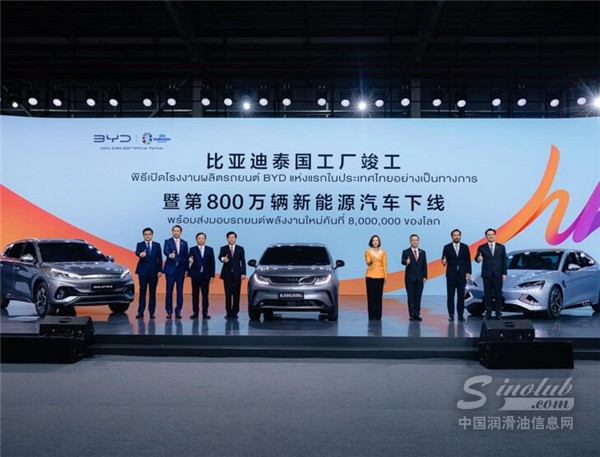 2024-07-20
潤滑油信息網
2024-07-20
潤滑油信息網
中國汽車制造商比亞迪標志著一個重要的里程碑,它于7月4日在泰國雷昂成立了新的制造廠,并慶祝其八百萬輛新能源汽車的生產。出席這次活動的有著名貴賓,包括泰國工業部長溫帕特拉·維切庫爾、中國駐泰國大使韓志強、泰國投資委員會秘書長納利特·瑟德施泰拉蘇滴和比亞迪主席兼總裁王傳福。

新工廠僅在16個月內完工,年生產能力為150,000輛汽車,包括沖壓、油漆、焊接、最后裝配和部件制造設施。該工廠的建立可望在該區域創造10000個就業機會。儀式還見證了海豚模型的揭幕儀式,成為第八百萬個新的能源載體。
Wichaikul贊揚比亞迪對新能源汽車部門的貢獻,強調該公司在推動泰國和整個東南亞國家聯盟(東盟)工業發展方面的作用。比亞迪是世界領先的汽車制造商,也是中國新型能源汽車工業的先驅者。比亞迪在泰國的投資及其先進的生產技術,將推動泰國和整個東盟新能源汽車工業的發展。
王對兩國政府、泰國客戶和合作伙伴的支持表示感謝。他強調比亞迪在泰國市場的成功,指出過去兩年比亞迪一直是泰國純電動汽車的主要銷售商。"目前,泰國每三輛電動汽車中就有一輛是比亞迪。展望未來,我們的目標是在泰國推出更純的電動和插入式混合動力車。
比亞迪近年來大幅擴大了其全球業務,在2023年實現出口同比增長337%,達到243,000輛汽車。今年上半年,比亞迪在全球銷售的新型能源汽車有137.7萬輛,同比增長28%。其中,出口超過203000筆,同比增長173.8%。比亞迪的新能源工具目前已在全球88個國家和地區投入使用。
自2021年5月v推出第一百萬輛新能源汽車以來,比亞迪僅用了三年時間就達到了800萬輛汽車這一令人印象深刻的里程碑。該公司計劃繼續擴大其全球市場存在,利用其先進技術和創新產品滿足世界各地消費者的不同需求。
在中國,新型能源車輛包括下列類型的車輛:
電池電動車:這些車完全由電池驅動,沒有內燃機。它們完全依靠電池儲存的電力來推進。
插插式混合動力車:這些車有內燃機和電池。它們可以通過插入外部電源充電,并且可以單獨短距離運行電力。內燃機用于更長的距離或當電池耗盡時。
燃料電池電動車:這些汽車使用氫燃料電池來發電,而這一電池為電動機提供動力。它們只產生水蒸氣作為副產品,被認為是清潔能源車輛的選擇。
BYD inaugurates Thailand factory and hits 8 million NEV milestone
Chinese automaker BYD marked a significant milestone by inaugurating its new manufacturing plant in Rayong, Thailand, on July 4, and celebrating the production of its eight millionth new energy vehicle (NEV). The event was attended by notable dignitaries, including Thailand’s Minister of Industry Pimphattra Wichaikul; Han Zhiqiang, Chinese ambassador to Thailand; Narit Therdsteerasukdi, secretary general of Thailand Board of Investment; and Wang Chuanfu, chairman and president of BYD.
The new plant, completed in just 16 months, has an annual production capacity of 150,000 vehicles and includes facilities for stamping, painting, welding, final assembly, and component manufacturing. The establishment of this plant is expected to create 10,000 jobs in the region. The ceremony also saw the unveiling of the Dolphin model as the eight millionth new energy vehicle.
Wichaikul praised BYD’s contribution to the new energy vehicle sector, highlighting the company’s role in driving the development of the industry in Thailand and across the Association of Southeast Asian Nations (ASEAN). “BYD is a world-leading automobile manufacturer and a pioneer in China’s new energy vehicle industry. BYD’s investment in Thailand, along with its advanced production technology, will drive the development of the new energy vehicle industry in Thailand and across ASEAN,” she said.
Wang expressed gratitude for the support from both governments, Thai customers, and partners. He highlighted BYD’s success in the Thai market, noting that the company has been the leading seller of pure electric vehicles in Thailand for the past two years. “Currently, one in every three electric vehicles sold in Thailand is a BYD. Going forward, we aim to launch more pure electric and plug-in hybrid models in Thailand,” Wang said.
BYD has significantly expanded its global presence in recent years, achieving a 337% year-on-year increase in exports in 2023, reaching 243,000 vehicles. In the first half of this year, BYD sold 1.607 million new energy vehicles globally, a 28% year-on-year increase. Of these, over 203,000 were exported, showing a 173.8% year-on-year growth. BYD’s new energy vehicles are now present in 88 countries and regions worldwide.
Since achieving the roll-off of its one millionth new energy vehicle in May 2021, BYD has reached the impressive milestone of eight million vehicles in just over three years. The company plans to continue expanding its global market presence, leveraging its advanced technology and innovative products to meet the diverse needs of consumers worldwide.
In China, the category of new energy vehicles includes the following types of vehicles:
Battery Electric Vehicles (BEVs): These vehicles are powered entirely by electric batteries and have no internal combustion engine. They rely solely on electricity stored in batteries for propulsion.
Plug-in Hybrid Electric Vehicles (PHEVs): These vehicles have both an internal combustion engine and an electric battery. They can be recharged by plugging into an external power source and can run on electric power alone for short distances. The internal combustion engine is used for longer distances or when the battery is depleted.
Fuel Cell Electric Vehicles (FCEVs): These vehicles use hydrogen fuel cells to generate electricity, which powers the electric motor. They produce only water vapor as a byproduct and are considered a clean energy vehicle option.

